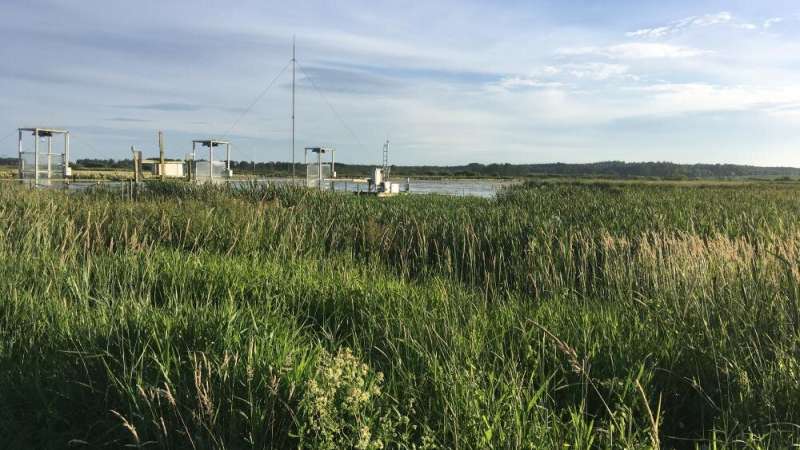An inundated riparian peatland in northeast Germany after 12 years of rewetting mainly colonized by Typha latifolia and instrumented with an automated chamber system for greenhouse gas flux measurements. Credit: Dominik Zak
Intact peatlands are habitats for many rare animal and plant species and important sinks for greenhouse gases. Many peatlands that have been converted to agricultural land should therefore be restored. A current study with IGB participation discusses different strategies for this.
The authors make clear that the most commonly used method of flooding former peatlands is problematic: it can cause large amounts of methane, a greenhouse gas, as well as nutrients to be released into the environment. Removing the topsoil or slowly rewetting could have more ecological sense in many cases.
Peatlands, whose areas once accounted for more than ten percent of the land in some regions of Europe, are important biodiversity hotspots and store carbon as well as nutrients. But most peatlands have been drained and used for agricultural purposes, such as cropping or grazing. With the beginning of the 1990s, a rethinking began: People started rewetting large areas of peatlands to restore their original function.
"At that time, people simply rewet them and thought the ecosystems would restore themselves in short-term," reported Dr. Dominik Henrik Zak. The scientist and peatland specialist is now working at Aarhus University in Denmark and is also a guest scientist at IGB. He has been investigating the rewetting of peatlands for many years. In a study published today in the Journal of Applied Ecology, "A call for refining the peatland restoration strategy in Europe," he and co-author Robert J. McInnes call for greater attention to be paid to the ecological and also social consequences of the chosen method when restoring peatlands.
Flooding former peatlands: Source of greenhouse gases and a period of more than 50 years until they regain a natural state
For example, the most common and cost-effective method used to date, large-scale flooding of former peatlands, also has undesirable effects: very large quantities of greenhouse gases are released, and nutrient inputs into the environment can also increase rapidly.
"The soil is degraded and mineralized. When water comes on top of it, a shallow lake is first formed, and the phosphorus bound in the soil is released. The phosphorus concentrations of such flooded peatlands are thereby 100 to 1000 times higher than in near-natural peatlands. The concentrations are so high because the peat is highly decomposed and mineralized, and the soils are often overfertilized if they were previously intensively farmed. In addition, large amounts of methane, which has a particularly strong impact on the climate, are released under these conditions," explained Dominik Zak.
Moreover, it takes more than 50 years for conditions similar to those in nature to develop and for plants typical of peatlands, such as mosses and sedges, to become dominant.
Alternative: Removing degraded peat soil before it becomes waterlogged has many advantages
An alternative under certain conditions is to remove the highly mineralized topsoil of the peatlands. "In the uppermost 20 to 50 centimeters, a large part of the phosphorus and other water polluting substances are present in mobile form," said Dominik Zak. This method is particularly useful in areas with somewhat steeper slopes and low groundwater levels. The drainage ditches are closed with part of the removed soil, so that the water level rises again by itself.
With this method, peatland-typical vegetation can develop within a few years, as Dominik Zak was able to show a few years ago using the example of the peatland in the Lehstsee lowlands. In other experimental areas, methane emissions were also reduced by a hundredfold. For the restoration measure to work, however, the groundwater level must be close to the peat surface. Topsoil removal is costly, however, and climate-friendly solutions must be found for its further usage, since a small amount of topsoil removal is sufficient to fill the drain ditches.
Slow rewetting as promising solution
The third approach which is introduced in this study is called "slow-rewetting." "We suggest that the use as grassland can be continued for a couples of years if the water level is increased by only few decimeters with even wetter conditions in the wintertime so that overall, the mineralization of peat becomes diminished. After about 10 years a full rewetting might be targeted enabling a new formation of peat," said Dominik Zak. Thus, positive effects of slow-rewetting can be expected already after about 10 to 15 years.
It is important to note that there is no "one fits all solution" for peatland restoration. Thus, depending on the drainage history and the specific characteristics of peatland sites under consideration, such as size, landscape position, soil properties, and the presence of valuable species, different rewetting strategies might be applied. "The flooding of agricultural peatlands might cause elevated emissions of methane and phosphorus as unpleasant side effects," warned Dominik Zak. As consequence in Denmark several planned rewetting projects became suspended by environmental authorities.
However, people often forget that also drained peatlands can be significant sources not only for greenhouse gases but also for nutrients due to rain-induced groundwater level fluctuations. Currently, the researcher is investigating different restoration approaches both in the field and in the lab at varying soil conditions. Results of this studies should support the decision making of applying different restoration strategies in certain areas to reach the restoration goals efficiently and preferably without negative side effects.
More information: Dominik Zak et al, A call for refining the peatland restoration strategy in Europe, Journal of Applied Ecology (2022). DOI: 10.1111/1365-2664.14261
Journal information: Journal of Applied Ecology
Provided by Forschungsverbund Berlin e.V. (FVB)
























